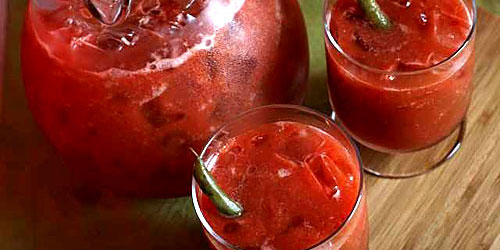
Favourite of Ernest Hemingway, birthplace of the Bloody Mary, haunt of generations of expat Americans in Paris — there are few watering holes that can boast the legacy of Harry’s New York Bar.
And as the venerable establishment prepares to mark its 100th birthday on Thursday, Harry’s Bar remains what it has always been, a small corner of Manhattan in the heart of Paris.
“Every time I’m in Paris I have to come here to get a cocktail,” former New Yorker Michael Formosa said sipping a Gibson — a Martini with a pickled onion instead of an olive.
“You can feel the whole history — it takes a very long time to create this kind of feel of a place,” said the 40-year-old, now a London-based consultant.
“I lived in New York for 12 years and this is like something you would find around the corner from Penn Station.”
Tucked away on a side street in central Paris under a red-and-gold neon sign, Harry’s Bar could not be more different from the traditional French brasseries and bistros that surround it.
Behind an aged wooden bar, white-aproned barmen expertly mix the driest of Martinis or pour out tumblers of single-malt Scotch. No coffee or wine is served in the evening and there is no music or television to distract from conversation.
“It’s not a trendy place,” owner Isabelle MacElhone told AFP in a quiet corner of the bar, “but this is why it will never be out of fashion.”
The MacElhones have been at the heart of Harry’s Bar since its opening on Thanksgiving Day 1911 — an event that will be marked this week with a party for 300 guests and the publication of a book on the bar’s history.
Harry MacElhone, a Scot from Dundee, was hired as bartender by original owner Tod Sloane, an American jockey living in Paris who opened “The New York Bar” after complaining he could not find a proper cocktail in the French capital.
Keen to recreate the atmosphere of a pre-Prohibition stand-up saloon in Paris, Sloane had the interior of a Manhattan bar completely dismantled and shipped across the Atlantic to Paris.
The original mahogany bar and walls, decorated with shields of dark wood bearing the insignia of US universities, remain fixtures of the place to this day.
Sloane sold the bar to Harry MacElhone in 1923, he put up his name above the door, and it has been known simply as “Harry’s” ever since.
The bar became a favourite of American expats in Paris, especially the “Lost Generation” of writers of the 1920s that included F. Scott Fitzgerald and the hard-drinking Hemingway, a regular for many years and a close friend of the MacElhone family.
 Based on the bar’s address at 5 Rue Daunou, Harry’s trademark advertising slogan — “Just tell the taxi driver: Sank Roo Doe Noo” — became a calling card for English-speaking visitors to Paris.
Based on the bar’s address at 5 Rue Daunou, Harry’s trademark advertising slogan — “Just tell the taxi driver: Sank Roo Doe Noo” — became a calling card for English-speaking visitors to Paris.
It has hosted film stars from Humphrey Bogart to Clint Eastwood.
Its famous list of clients is matched by its famous cocktail creations.
The Bloody Mary, a mixture of tomato juice, vodka and spices, was first served at Harry’s in 1921, and the French 75, White Lady and Sidecar were dreamt up at the bar as well.
Harry died in 1958 and the bar was taken over by his son Andy and then his grandson Duncan, Isabelle’s husband, who died in 1998. Their son, 23-year-old Franz-Arthur, plans to eventually take over the business.
